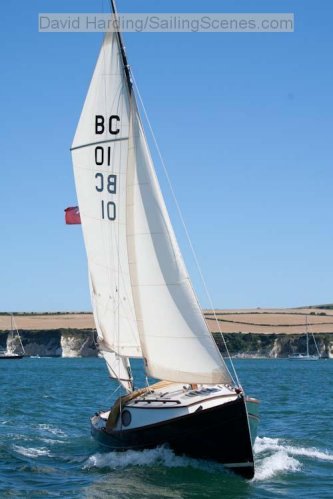I got up the nerve and installed the depth sounder. The first job was to bore a large hole for the transducer. I did this with a hole saw and all went smoothly. The saw was smoking by the end and I think is no good for anything more now. The bottom is thick, over 20mm, plus plastic flaps and a final thin ply layer securing the plastic in place. Quite reassuring to see how thick it is. I had to file it out slightly before the transducer would fit through. Then I smeared epoxy around the cut edge and, after that had set, pushed the transducer in place. I have fixed a square wooden plate on top of it which screws down onto the boat bottom. The whole thing is quite firm and the transducer face is almost flush with the bottom of the boat. Then I drilled a second largish hole in the main bulkhead for the display's electrics to poke through. Slightly unnerving to see the bulkhead is just a double layer of foam with epoxy/fibreglass on each face. It seems very strong.
To stop the plate on top of the transducer getting fouled in the sump, I have covered it in self adhesive copper tape. It looks lovely and shiny now, but I presume it will go green in the sea. I may tap in some copper tacks to hold it in place in case the adhesive works loose.
The display fits in neatly. It isn't possible to make the holes behind it waterproof. There is a foam rubber seal behind the unit which is supposed to keep water out, so I hope it works.
Then I had to wire it all up. I had no experience of doing this. I got small reels of wire and crimp fasteners from a car accessory shop. The instructions for the switch board were rudimentary. I traced everything step by step and finally wired it to the battery to test it. To my amazement it worked first time. Emboldened, I wired in the GPS unit and that worked too. Rather than risk messing it up by disconnecting things, I made a wooden box for it and managed to slot the switchboard in through the back and screwed it on he front. After much thinking I have fixed it under a side deck, next to the companion way. It slots in very neatly and can be reached from the cockpit. I have had to fit a wooden cover over the back of the display unit, to cover the wires and screws. I will fix a picture to it at some stage. I then spent the next half hour just turning things on and off and admiring the fact that everything works.
Having completed the wiring, I think I have just about finished all the jobs I had set myself for the winter. Now I "just" need to do the painting. I swept up all the leaves and dirt and washed the side decks. There is now a little painting to finish in the cabin. After that it is the topsides, the hull and a white antifoul boot top. Hope I can get it all done before launch. We go for a three week holiday at the end of March, so there isn't that much time.
Subscribe to:
Post Comments (Atom)






Hi Julian, you are getting along really well now you are under cover. I like the switch panel, where did you get it from and what is connected to it? I would be interested to see more about the wiring on your boat if you can show it.
ReplyDeleteRegards,
Andy
Hi Andy
ReplyDeleteIt is a bog standard three switch panel with a cigarette lighter socket. I got it from Force 4, but I think all chandlers carry them. About £23. It looked fairly flimsy with all the gubbins exposed at the back, but it seems to work. The instructions were minimal.
I figured out the wiring of the switches, which is fairly straight forward. It only gave instructions for wiring in two batteries from a selector switch. I've only got one, a 7 Amp hour Powertank thingy, but again, there seemed only one way to do it and it works. There is a battery meter, which flips to full power when I try it. Either it is working fine, or I have just shorted across it. The battery has got a "needs charging" LED on it anyway, so that is not important.
Most connections are just with little screww blocks I bought at Halfords. I bought some ring terminals for the battery from there as well, along with two reels of thin red and black wire. The only problem was that the wire was so thin, crimping the terminals on was a bit of a hit or miss affair. I got through several before it worked. The problem is that the right sized rings for the wire are too small for the battery, and vice versa.
I have wired in the depth sounder and the GPS to two switches, and I plug the VHF handheld radio into the cigarette socket to recharge it. That leaves one spare switch, so I have just ordered two LED strips for cabin lights. I'll probably foul up the whole system trying to fit them! All the white trunking just comes from a local DIY shop and the 1W solar charging panel comes from Maplins at about £10. I'm hoping that over the week on a mooring that can keep the battery topped up.